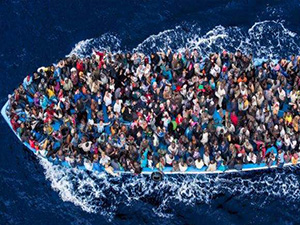 During the recent G7 Summit held in Sicily (my lovely home town), the issues of migrant crisis has not received the attention that Italian Prime Minister, Gentiloni, would have liked: the official communique and the various press interviews that political leaders, including Macron, has, on one hand, emphasised the need to offer a coordinated answer at international level. On the other hand, they have stressed the principle that every single country maintains its own sovereign right to control its own borders as it best wishes. Nobody, however, seems to be able to answer the simple question “At the end of the day, do migrants have or not a positive impact on the economy of the host country?”. The lack of answer is not, at all, surprising because even international experts do not offer clear and unambiguous answers. During the recent G7 Summit held in Sicily (my lovely home town), the issues of migrant crisis has not received the attention that Italian Prime Minister, Gentiloni, would have liked: the official communique and the various press interviews that political leaders, including Macron, has, on one hand, emphasised the need to offer a coordinated answer at international level. On the other hand, they have stressed the principle that every single country maintains its own sovereign right to control its own borders as it best wishes. Nobody, however, seems to be able to answer the simple question “At the end of the day, do migrants have or not a positive impact on the economy of the host country?”. The lack of answer is not, at all, surprising because even international experts do not offer clear and unambiguous answers.
With all this uncertainty, it is important to analyse the problem in details before taking irreversible decisions. I hope European politicians listen. Here in Asia, we see the experience of China, where one of the main success factors of economic growth and stability has been the control of population flow from rural areas to the urban areas. In 1958, China adopted the Hukou system, initially prohibiting farmers from moving to the cities. The Hukou system has, little by little, being relaxed, but still today, limits this migratory flow. Thanks to this – and other measures – China has grown by 10% for decades. Clearly, we in Europe cannot entirely copy the China model, but we can at least start the debate in order to set the stage for more study. Here, we also only discussing the economic aspect, neglecting – for the time being – the very important humanitarian and social aspect |
| 1) When discussing about the “economic impact of migrants on the economy of the host country”, we should clarify what we mean by “economic impact”. Do we refer to the growth, on aggregate, of the country’s GDP? Or do we refer to the welfare of the average citizen, that the growth of the GDP/capita? Clearly, when production factors – land, capital, labour – increase, the aggregate GDP tends to increase, but we should be more concerned about the GDP per head. If Germany welcomes 800,000 migrants and Germany’s GDP grows by 1%, then the GDP per head grows by zero (Germany’s population is 80mn). Hence, the growth of the welfare of the average German citizen is nil, zero. Smoke in the eye. |
| 2) In the short term – this is the so-called ‘static vision’ – the GDP per head of the host country would only grow if the average income of the migrants were higher than the national average. In Italy, this means that the GPD per capita would rise if, on average, each migrant were to produce a value of 27,000 Euros per year. Highly unlikely. |
| 3) In the long term, however, it is possible that the GDP per capita would be boosted, should, at some time in the future, the average income of migrant reach the national average. This is the crux of the matter. According to various researches, the long term benefits of migrants relate to the increase of efficiency of resources, higher tax income, better demographic composition (for example, improvement in the dependency ratio), and an increase in the creativity due to increased diversity. However, the results of those studies are not conclusive and do not offer clear answers.
I discuss briefly the issue of diversity as an example that a quick read of the statistics may lead to wrong conclusions. Researchers have found that, looking at the worldwide migrations from 1960 to 2010, a higher degree of diversity had led to economic benefits for the host country. This would appear to be an argument in favour of an open door policy. But a more careful read would reveal that the positive effects are concentrated in the period 1960-2000 and that, on the contrary, during the decade 2000-2010, the impact turns negative. Going deeper, it is found that the benefits are higher when the host country is a developing economy, while if the host country is a developed economy, such as G7 member, then we have negative effects of diversity of the GDP per head. Finally, even when research finds a correlation between economic growth and migratory flow, the question remains as to the direction of causality between those two variables: is it the migratory flow that causes economic growth, or is it economy growth that attracts migrants? We are, therefore, in uncharted territory, with positive and negative effect all muddled up. Going back to China, we know that the success of Chinese migratory policies has been founded on the total and unconditional acceptance by the migrant population of the rules and the institutional framework of the host location, without questions being asked. The social pact has not been questioned. And in Europe?
The summary of the above piece was published in Caixin and in Radiocor. |
